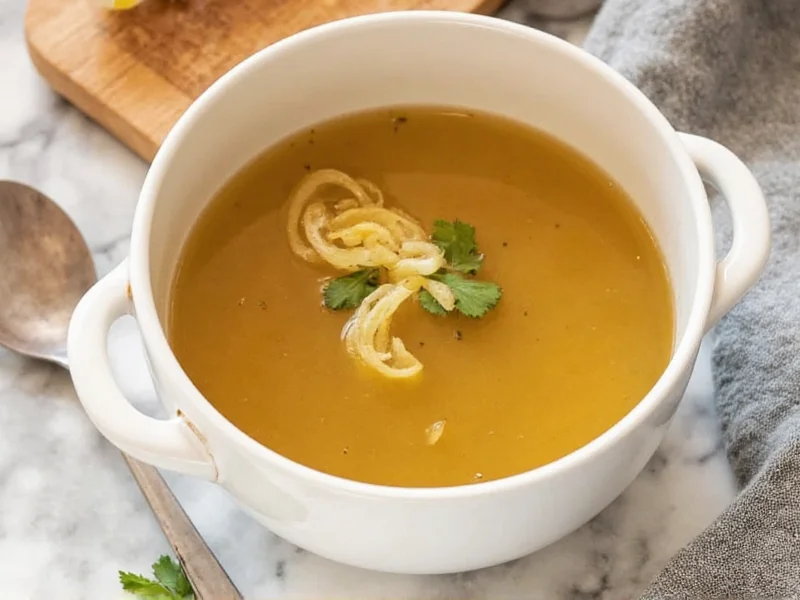Creating exceptional chicken broth soup from scratch transforms ordinary meals into culinary experiences. Unlike store-bought versions filled with preservatives and excessive sodium, homemade broth delivers unmatched depth of flavor and nutritional benefits. After two decades of refining techniques through professional kitchens and home cooking experiments, I've discovered the precise balance that produces consistently clear, flavorful broth every time.
Why Homemade Broth Matters
Commercial broths often contain MSG, artificial flavors, and high sodium levels that mask rather than enhance natural flavors. Homemade chicken broth soup recipe provides:
- Natural collagen and gelatin for gut health
- Customizable sodium levels for dietary needs
- Rich umami depth impossible to replicate commercially
- Economical use of kitchen scraps and leftover bones
Essential Ingredients Breakdown
The magic happens through careful ingredient selection. Each component serves a specific purpose in developing complex flavors:
| Ingredient | Function | Professional Tip |
|---|---|---|
| Chicken bones (2-3 lbs) | Collagen source for body and mouthfeel | Use roasted bones for deeper flavor |
| Onion (1, unpeeled) | Sweetness and aromatic foundation | Leave skin on for golden color |
| Carrots (2, scrubbed) | Natural sweetness and color | Avoid overcooking to prevent bitterness |
| Celery (2 stalks) | Herbaceous notes and complexity | Include leaves for extra flavor |
| Garlic (2 cloves) | Depth and savory undertones | Smash, don't chop, for gradual infusion |
Step-by-Step Preparation Guide
Follow these precise steps for restaurant-quality results:
Preparation (15 minutes)
- Rinse bones under cold water, removing any meat scraps
- Chop vegetables into large chunks (no need for precision)
- Place all ingredients in a 6-8 quart stockpot
- Cover with 3 quarts cold water (1 inch above ingredients)
Cooking Process (3-4 hours)
- Bring to gentle simmer over medium heat (do not boil)
- Skim foam aggressively during first 20 minutes
- Reduce heat to low, maintaining bare simmer (1-2 bubbles/second)
- Cover partially, simmer 3 hours for standard broth, 4 hours for richer version
- Remove large solids with slotted spoon after 2 hours
Finishing (20 minutes)
- Strain through cheesecloth-lined sieve for crystal clarity
- Cool broth quickly in ice bath to preserve freshness
- Refrigerate overnight to solidify fat layer for easy removal
- Store in airtight containers with 1-inch headspace
Pro Techniques Most Recipes Don't Mention
Professional kitchens use these advanced methods to elevate broth quality:
- The Acid Test: Add 1 tablespoon apple cider vinegar to help extract minerals from bones without affecting flavor
- Temperature Control: Maintain 180-190°F (82-88°C) for optimal extraction without clouding
- Double-Straining: First through coarse sieve, then through coffee filter for absolute clarity
- Concentration Method: Simmer finished broth an additional hour to create versatile soup base
Avoiding Common Broth-Making Mistakes
Even experienced cooks make these critical errors:
- Boiling instead of simmering - Causes emulsification of fats, creating cloudy broth
- Overloading vegetables - Results in bitter, vegetal flavors dominating chicken essence
- Insufficient skimming - Leaves impurities that create off-flavors
- Using hot water initially - Prevents proper extraction of impurities
Storage and Usage Recommendations
Maximize your broth's shelf life and culinary potential:
- Refrigeration: Store up to 5 days in airtight containers
- Freezing: Portion in ice cube trays, then transfer to freezer bags (keeps 6 months)
- Vacuum Sealing: Extends freezer life to 1 year without flavor degradation
- Reduction: Simmer to 1/4 volume for concentrated soup base (1 tablespoon = 1 cup broth)
Variations for Dietary Needs and Preferences
Adapt this foundational chicken broth soup recipe for specific requirements:
- Low-Sodium Version: Omit added salt, use extra herbs for flavor
- Keto-Friendly: Add 1 tablespoon olive oil during simmering for healthy fats
- Immune-Boosting: Include 1-inch ginger and 4 shiitake mushrooms
- Quick Weeknight Version: Use pressure cooker for 45-minute preparation
Frequently Asked Questions
How do I fix cloudy chicken broth?
Cloudiness usually results from boiling instead of simmering. For immediate correction, whisk 1 egg white into warm broth, bring to 160°F (71°C), then strain through cheesecloth. Prevention is better - maintain gentle simmer throughout cooking and skim foam thoroughly during initial heating.
Can I use rotisserie chicken bones for broth?
Yes, rotisserie chicken bones work well but require adjustments. Reduce cooking time to 2 hours since bones are already cooked, and decrease salt by 50% as commercial rotisserie chickens contain significant sodium. For best results, combine with raw chicken feet (available at Asian markets) to boost gelatin content.
Why isn't my broth gelling when refrigerated?
Proper gelling indicates sufficient collagen extraction. If broth doesn't gel, you likely used too few bones or insufficient cooking time. Next batch: increase bone-to-water ratio (3 lbs bones per 3 quarts water), include joints and feet, and maintain gentle simmer for full 4 hours. Acidic components like tomato paste or vinegar also improve extraction.
How can I deepen the flavor without making it cloudy?
Roast bones at 400°F (200°C) for 30 minutes before simmering to develop complex Maillard reactions. Add 1 dried shiitake mushroom or 1 teaspoon dried porcini powder for umami depth. Finish with 1 teaspoon fish sauce (dissolved in broth) for savory complexity that disappears into the background flavor.











 浙公网安备
33010002000092号
浙公网安备
33010002000092号 浙B2-20120091-4
浙B2-20120091-4